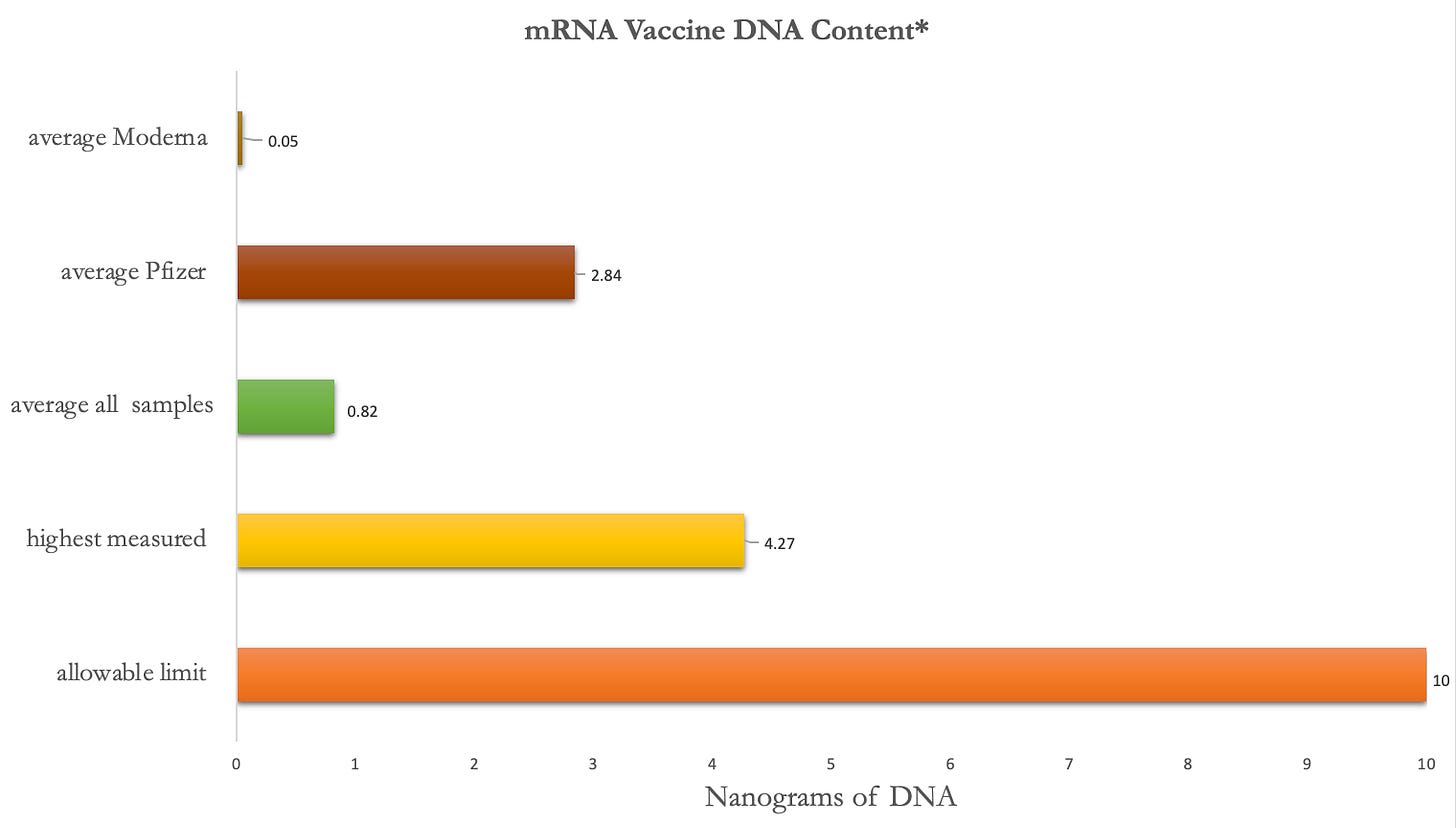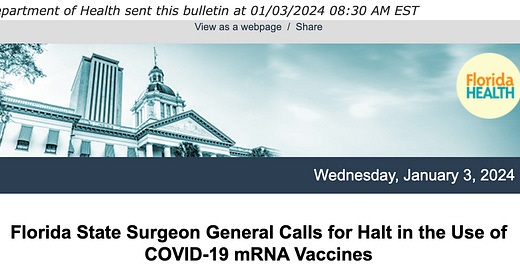DNA in Covid-19 vaccines: 7 pieces of context missed from Florida Surgeon General’s unnecessary warning
Happy 2024!
The first public health rumor of the year came in hot: the Florida Surgeon General sent an email airing his concerns about mRNA Covid-19 vaccines: billions of DNA fragments per dose of Covid-19 mRNA vaccines.
This isn’t the first time he questioned the safety of mRNA Covid-19 vaccines, but it is a new angle. As always, each claim should be evaluated individually based on merit.
Let’s dig in.
First, the kernel of truth.
Rumors typically have a kernel of truth—a core accuracy surrounded by dubious claims. And, in the most complex claims, the molecular biology required to explain in detail why the claims are unfounded spans a few semesters’ worth of material. This makes rumors like these particularly dangerous: it’s hard for the general public to separate hypothetical (and unfounded) concerns from true risks. And it takes a long time to debunk.
What’s the kernel of truth here? There are DNA fragments in Covid-19 vaccines.
But there are seven important pieces of context missing:
1. “Billions of DNA fragments per dose” is relatively small.
Ladapo got this statistic from a recent preprint study with serious methodological problems. But if we assume this number is true, when we look at microscopic levels, there are trillions and trillions of particles in vaccines. For reference, there are about 13 trillion strands of RNA in a Pfizer vaccine alone. “Billions” turns out to be a very small relative quantity.
2. DNA fragments are in ALL vaccines.
Producing vaccines requires us to use cells, and cells contain DNA. This is why DNA fragments are found in all vaccines. DNA fragments aren’t limited to vaccines, either. Insulin, for example, also contains small amounts of DNA from the bacteria used to make it.
Regardless, we try to limit the number because it can impact the immune response. We aim for the purest form of vaccines so they work as intended and consistently. The FDA requires less than 10 ng/dose of residual DNA fragments in any vaccine for full approval.
Multiple regulators across the globe have consistently found vaccines to have acceptable levels of DNA fragments. Even the flawed preprint confirms Covid-19 vaccines’ DNA content is far below any levels indicating a safety or manufacturing concern (see below).

3. Cells have safety mechanisms.
Even with small fragments of DNA, humans have a default protection response: when exposed to foreign DNA, whether from food, air, viruses or, yes, vaccines, our bodies destroy it through a shredder (called a DNase)—the DNA gets chopped into tiny fragments and our body recycles them. Our defense mechanisms against foreign DNA are much more extensive than this, but this is a major barrier.
4. It is biologically impossible for random DNA fragments to integrate into our genes.
Even if some DNA fragments are left behind from the shredder, they cannot be inserted into our genes and change our DNA, as Ladapo falsely insinuates. There are two main reasons:
DNA fragments lack opportunity. The vaccines lack the basic tools necessary to alter our genes. (See this previous YLE post.)
DNA fragments lack stability. The DNA is fragmented and, thus, unstable inside the cell. This means it cannot create a dangerous protein.
5. DNA fragments will not impact our children’s genes, either.
Ladapo claims that DNA fragments will impact not just our genes but our children’s genes.
First, if foreign DNA does not affect our genes, it will not affect our children’s genes.
Second, we have two important preclinical studies—studies before human clinical trials—that show the claim is false:
Where does the vaccine go? One study gave a massive dose of vaccine (equivalent to hundreds of times the relevant human dose) to rats and found the vast majority went to lymph nodes, liver, and spleen. About 0.1%—a trivial amount—went into the ovaries and testes. Covid-19 vaccines are not delivering significant doses of foreign DNA to reproductive organs. (And any tiny, tiny, tiny dose that theoretically may get there will quickly meet its demise by the cell’s protection mechanisms.)
Do DNA fragments change genes? Another study evaluated if the vaccine (meaning all parts of the vaccine, including any impurities) impacts the genome through genotoxicity assays. The studies showed no effect.
We would all prefer to have human data, but there’s a great reason why this hasn’t been done in humans: it would require us to surgically take samples from the relevant sites (ovaries and testicles), which would be invasive and unethical.
6. Lipid nanoparticles are safe.
mRNA is very fragile, so it needs to be packaged in fat bubbles (i.e., lipid nanoparticles) to get it to go where it needs to be. Ladapo claims that these lipid nanoparticles make them unsafe.
We’ve seen this rumor throughout the pandemic. But scientists have been working with lipid nanoparticles since the 1960s. There is no evidence that these fat bubbles are dangerous to humans. They get rapidly metabolized and cleared from the body in days.
7. Simian Virus 40 promoter/enhancer (SV40) is also not a concern.
Finally, Ladapo argues that there is a special danger to the mRNA vaccines because the template used to make the mRNA vaccines uses a piece of SV40. This is totally unfounded.
First, some basics. SV40 is a virus first identified in monkey cells, and now its parts are used as a molecular biology tool. The SV40 virus was not used to produce the Covid-19 vaccines; only one part was used (a sequence called a promoter).
For some time, there was concern about the SV40 virus (not the promoter). The whole SV40 virus was once suspected of causing cancer in humans because of some concerning lab studies. In the 1960s, it was discovered SV40 had contaminated some of the polio vaccines because it was present in the cell cultures used to make them. However, we now know even the virus itself is not a concern—studies following polio-vaccinated people for decades found no difference in their risk of cancer compared with those who never received SV40 virus-containing vaccines.
If the virus itself doesn’t cause cancer, there’s no reason to be concerned about small fragments of the promoter.
Bottom line
There are trace quantities of DNA fragments in our mRNA vaccines. But our amazing human immune systems know what to do.
Regardless, we have been tracking the safety of Covid-19 vaccines at unprecedented levels across the globe for more than three years. Scientific evidence from the lab, clinical trials, and epidemiological real-world data continue to verify a highly favorable profile of benefit to risk of Covid-19 vaccines.
Covid-19 vaccines save lives. Unfortunately, many people—including 8,288 Floridians in 2023 alone—continue to lose their lives to Covid-19. Don’t let rumors get in the way of protecting yourself and living a healthy life.
Love, YLE, EN, and KP
Kristen Panthagani, MD, PhD is an emergency medicine physician at Yale. In her free time, she is the creator of the medical blog You Can Know Things. You can subscribe to her newsletter here.
Edward Nirenberg is a biochemist, aspiring medical student, and author of a fantastic vaccine newsletter.
“Your Local Epidemiologist (YLE)” is written by Dr. Katelyn Jetelina, M.P.H. Ph.D.—an epidemiologist, wife, and mom of two little girls. During the day, she is a senior scientific consultant to several organizations. At night, she writes this newsletter. Her main goal is to “translate” the ever-evolving public health world so that people will be well-equipped to make evidence-based decisions. This newsletter is free, thanks to the generous support of fellow YLE community members. To support this effort, subscribe below:










I do not agree with your dismissal of Dr. Ladapo's concerns around the potential dangers of the mRNA products. This is a complex issue which requires a much more thorough analysis than you have presented.
1) The quantity of DNA fragments deemed acceptable is based on traditional vaccines which are not encapsulated in LNPs which are specifically designed to protect the encapsulated mRNA (and the trace DNA contaminants) until they can enter a host cell's cytosol. In other words the risk of these DNA contaminants are greater when they are encapsulated inside the lipid delivery mechanism. Yet the FDA has not modified their assessment of risk accordingly. It is illogical to compare mRNA inside of LNPs with traditional vaccines.
2) Ladapo is NOT claiming that these products WILL result in the integration of said fragments into our genome. He is merely asking for evidence that they WON'T. Citing genotoxicy studies isn't, as he says, adequate to ensure this is may not be happening on a small scale.
3) Your statement "It is biologically impossible for random DNA fragments to integrate into our genes" is not substantiated by the arguments given. In fact it contradicts Dr. Marks' assurance that it is "implausible". There is a world of difference between impossible and implausible, especially given the fact that billions of people have been vaccinated. The reason why Dr. Marks has a tempered position is that he knows that FDA's own guidance around DNA vaccines acknowledges that integration is a possibility even though DNA vaccines do not have DNA integrase in them either. The fact that contaminant DNA "lacks stability" does not mean that none will survive long enough to be integrated.
4) This leads to your position about "billions" being relatively tiny compared to "trillions". No argument there. But a billion is a big number on its own, especially with regard to "implausibility". If only one in a million DNA contaminant strands get integrated that would result in thousands of cells with altered DNA.
5) We all agree that LNPs go places outside of the deltoid muscle. The bio distribution study you cite indicates that 0.1% get to the ovaries and testes. Is that really trivial? At what level would it be non-trivial in your opinion? Two points about this. The levels in the ovaries attained that concentration after 48 hours. Levels were still rising when the observational period ended. We don't know how much eventually ends up there. Moreover, this study was only made public after a FOIA request to the Japanese medical authorities in the Spring of 2021. Why didn't the FDA know about it? Isn't it their job to demand these studies from the vaccine manufacturers? How many people would have had second thoughts about getting jabbed if they knew that a small portion of the inoculate would migrate to the spleen, the liver, the heart, the ovaries and the brain? Would their concerns have been reasonable?
6) The lipid nanoparticles aren't just little bubbles of fat. The design of these particles is one of the major breakthroughs in bringing these products to market. They are designed differently depending on the payload being delivered. Medicine in the form of cancer therapy will be encapsulated in a different kind of "bubble" than an mRNA vaccine. The LNPs for these vaccines are designed to be pro inflammatory to incite an immunologic response. It should be of some embarrassment to the FDA that the bio distribution studies show that these things go all over the place, albeit in limited quantities. That being the case, one cannot dismiss the possibility that these particles could be responsible for organ inflammation in the form of irregular menses, myo/pericarditis, bells palsy, transverse myelitis, etc. etc. in a small subset of vaccine recipients. Given the fact that a quarter of a billion people in this country have gotten the vaccine that the three hundred thousand serious adverse events reported in VAERS may be due to the vaccine? Shouldn't we expect the CDC to do a serious investigation into these reports on behalf of the public?
7) 8,288 Floridians have lost their life to Covid-19? Your citation does not indicate the vaccination status of those fatalities. Are you suggesting that they were all unvaccinated? What exactly are you insinuating here? That Ladapo is somehow responsible for their deaths? He didn't prohibit people from getting the jab. 70% of Floridians are fully vaccinated.
There's a lot more we don't know about this technology. Posts like this do not aid in discovering more. mRNA technology could eventually be a transformative weapon against disease and infection but right now the public doesn't trust it, and for good reason. By dismissing reasonable requests for more information in this fashion you are unwittingly doing far more damage than you realize.
Thank you very much for an excellent analysis and response to more misinformation from Florida. Unfortunately, Ladapo's statement already hit the national press and was widely reported. This article needs to be sent to the news media so they can report the truth.